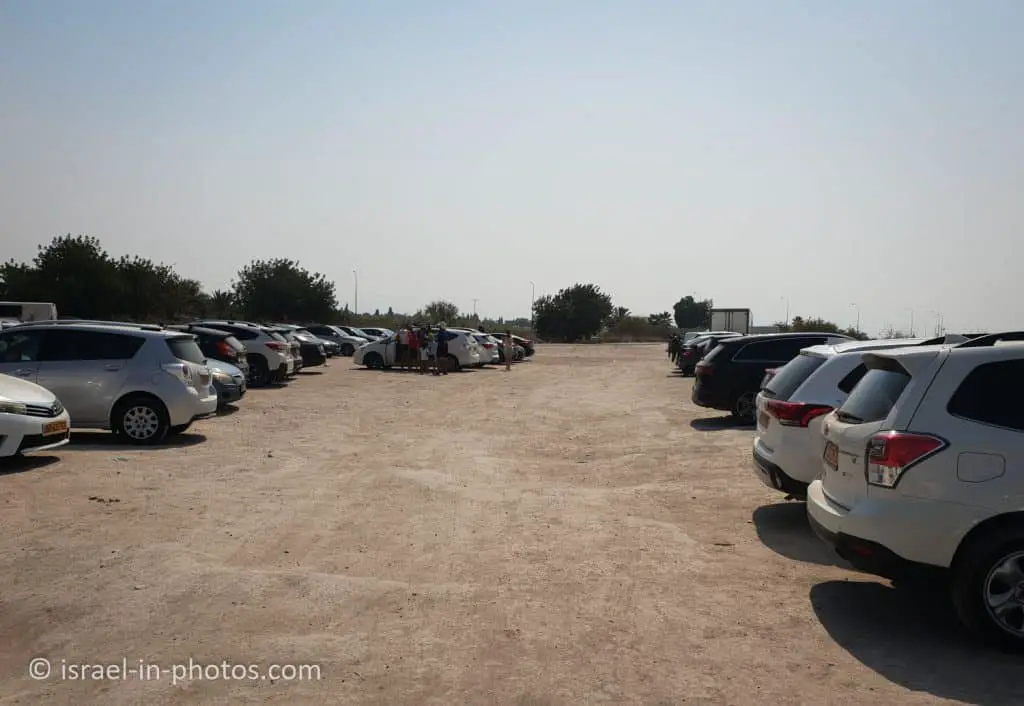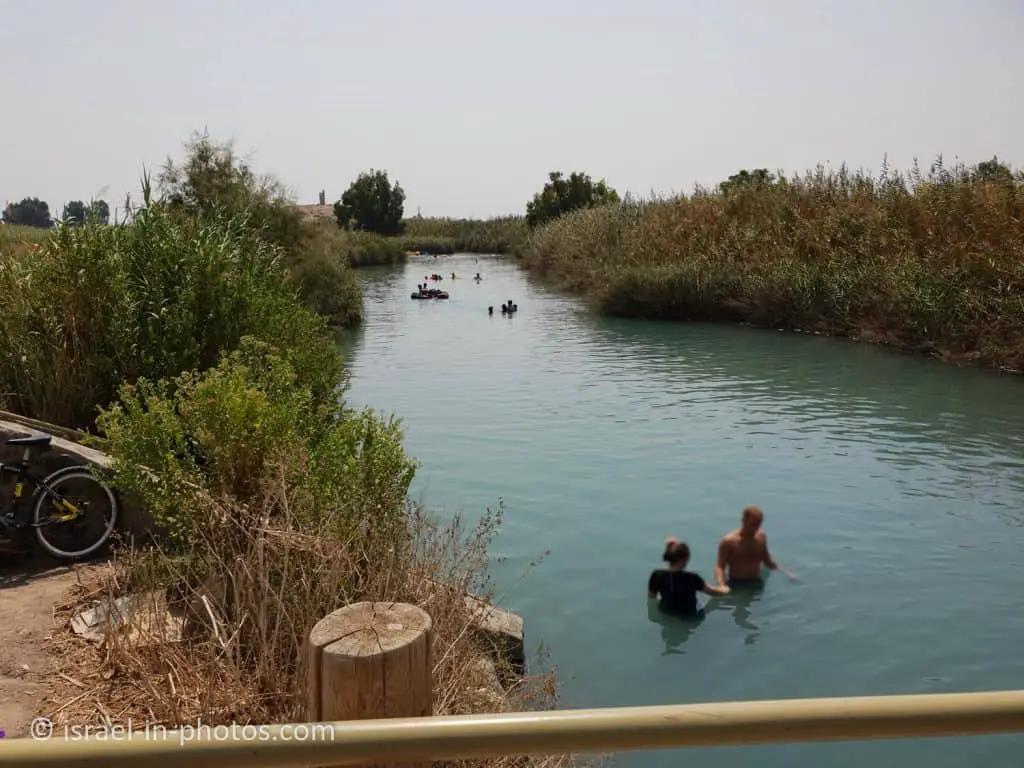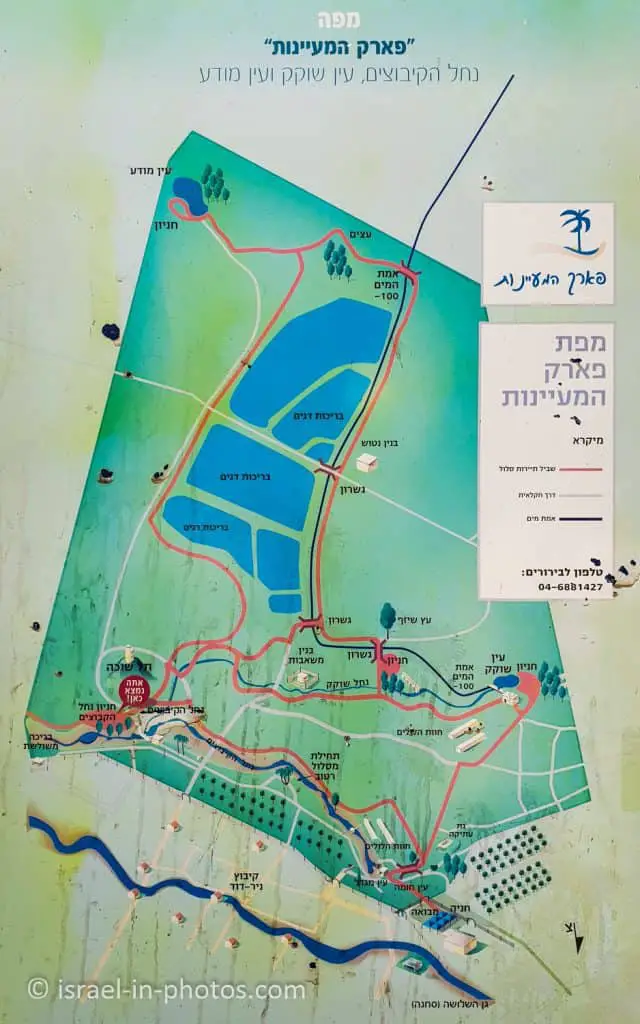Nahal Kibbutzim – Full Visitors Guide to the Water Hike
Nahal Kibbutzim is part of Spring Valley Park in Beit Shean valley. It offers a water hike with water slides, a pool, and a picnic area. Thus, it is the perfect place for the hot summer days.
Table of Contents
Map
Nahal Kibbutzim is located near Nir David and Mesilot in Beit Shean Valley. Nahal Kibbutzim nature reserve is part of Spring Valley Park. Also, in Spring Valley Park, you can find Ein Migdal, Ein Shokek, Ein Moda, and Tel Shukha. And all of them are marked in the following interactive map.
Directions for drivers: Link to Waze and Link to Google Maps
Directions for public transport: Link to Moovit
Interactive map of the area:
And here is a map of Spring Valley Park:
Note: you can click on the map to enlarge it.
You can see Nahal Kibbutzim at the bottom part of the map above. And the water trail begins at the bottom center and ends at the bottom left corner.
Directions
The parking is located near the intersection of roads #669 and #6667. To get there, you can set Waze to this point.

Trails
Nahal Kibbutzim water hike offers a loop trail. You go along the river in one direction and, in return, walk inside the water. Here is an interactive map from israelhiking.osm.org.il where this trail is marked:
| Name | Color of the Trail on the Map above | Description | Distance (km) | Total climb and descent (meters) | Notes |
|---|---|---|---|---|---|
| Nahal Kibbutzim Water Hike | Blue | The marked trail starts at the parking and leads to the beginning of the wet hike (the third bridge over Nahal Kibbutzim). And then you return by walking in the river. | 2.1 | 26 | You can go in the water in both directions. But under the bridges, there are one-way water slides. On both sides of each bridge, there are stairs. Thus, you can exit the water and return to the stream. |
Thus, the length of the water hike is 2.1 km. A little more than one km in each direction.
Entrance Fee
Free.
Opening Hours
When entering Nahal Kibbutzim, I did not see opening hours anywhere. But according to the following sign, you can be at the park only during the opening hours. And since it is part of Spring Valley Park, here are the opening hours of Spring Valley Park:
Sunday – Thursday, and Saturday: 08:00 – 17:00 (16:00 in winter)
Friday: 08:00 – 16:00 (15:00 in winter)

When to Visit
This is a popular place. Thus, to avoid the crowds, I suggest visiting early, before 9:30. This is especially important during weekends, holidays, and the school summer vacation.
Dogs
You can enter Spring Valley Park with strapped dogs. But your dog should be a good swimmer if you plan to complete the Nahal Kibbutzim water hike.
How Deep is Nahal Kibbutzim?
We visited in August, and during most of the Nahal Kibbutzim water hike, the water level was 130 – 160 cm. There also were several shallow sections (mainly near the bridges) and several deeper areas.
What Should You Bring to the Trail?
Almost all of this trail has no shade. Thus, bring plenty of water, sunscreen, and hats. Moreover, it would be helpful to have water shoes and an inflatable water mattress (or something similar where kids can rest and you can store your belongings). Moreover, sealable plastic bags for purses and phones are a good idea.
Picnic and Barbeque
Lighting fire is allowed in designated areas. These areas have tables and dustbins. Thus you can prepare a barbeque.

Lodging and setting up tents are permitted in designated areas, as indicated by the signs in the park.
Restrooms
There are toilets, a convenience store, and drinking water facilities at the entrance to Spring Valley Park. But there are no restrooms along the Nahal Kibbutzim water hike.
Spring Valley Park
Since Nahal Kibbutzim is part of Spring Valley Park, I would like to include a brief description section.
Spring Valley Park – Park HaMaayanot is home to three of the Beit Shean Valley’s most abundant and attractive springs that flow at the foot of the high cliff wall of Mount Gilboa.
Spring Valley Park is an unusual site for Israel. On the one hand, part of it is a nature reserve, while on the other, the springs that flow here – Ein Migdal, Ein Shokek, Nahal Kibbutzim, and Ein Moda – are devoted to recreation. In addition, there is another unusual feature: both the springs and the nature reserve are situated right in the heart of fields belonging to three kibbutzim: Nir David, Mesilot, and Reshafim.
Note: unless stated otherwise, the source of all quotes is KKL.
Why was the Park Created?
The park was created out of necessity, and out of necessity, it was closed to vehicles. Before it was established, the area between the springs was a neglected no man’s land that was crowded with thousands of visitors in the summer. The crowds, the noise, the dust raised by passing cars, and the appalling quantities of litter all damaged the natural landscape and made it impossible for anyone to enjoy the site. The area was crying out for help.
KKL-JNF, the South Jordan Drainage Authority, the Emek HaMaayanot Regional Council, the Nature, and Parks Authority, the Government Tourism Company, and the Ministry of Agriculture all joined forces to establish the park, develop it minimally without encroaching on the natural landscape and provide a unique water leisure facility unmatched anywhere else in the country.
Visiting Spring Valley Park
Entrance to the park is free of charge: you can explore it on foot without paying a penny, and you can bring in your own bicycle without paying, too. Some visitors, however, will find the distance between one spring and the next too great to cover comfortably on foot, especially when encumbered with a picnic cooler. A cheap and convenient solution to this is the road train that shuttles back and forth, and which for 20 NIS will carry you from one spring to the next. There are also golf buggies and bicycles for hire at a variety of prices.
Payment: Parking and entrance to the park on foot or one’s own bicycle are free of charge.
Transport within the park: Bicycles and golf buggies that hold between four and eight people are available for rent. The road train that provides a shuttle service between the springs departs every hour and a half. You can get on it with your picnic cooler, get off at one of the springs, move on to the next spring or your departure point. There is a charge for the use of the shuttle or a club car.
Combined ticket: Combination tickets that include visits to Gan HaShlosha National Park and Gan Guru are available at reduced prices.

What is the Origin of the Water in Spring Valley Park?
Before going any further, we need to solve the riddle of the abundance of water in the valley. How is it that we find such generously flowing springs in the comparatively arid Beit Shean Valley, which receives no more than 300 mm of rainfall per year? The answer lies on Mount Gilboa. Mount Gilboa is the northerly section of the Samaria Mountains, which receive very considerable amounts of rain. Because of the way the layers of rock in the Samaria region are configured, rain that falls between Nablus and Mount Gilboa in northern Samaria flows underground towards the Beit Shean Valley, where it emerges in the form of springs. In other words, most of the water flowing in Spring Valley Park – Park HaMaayanot started as rain that fell on Samaria.
And now, we will visit the water trail.
Nahal Kibbutzim Water Hike
After leaving the car at Nahal Kibbutzim parking, we start walking to the beginning of the trail. You can easily spot this area by the cluster of trees.
The parking and Tel Shukha in the background:



It took us three minutes to reach the picnic area. The picnic area is spread along Nahal Kibbutzim, and there is also a pool.




After dipping in the pool, we headed to the beginning of the water hike.

You will pass two bridges on the way, and at the third bridge, the wet trail begins. As you can see in the photo above, big pipes were installed under the first two bridges. These pipes are used as water slides.

But since the water flow was in the opposite direction, we used the paved path to walk to the beginning of the wet trail.


Tel Shukha
You can see Tel Shukha from many spots along this trail. And after completing this track, you can climb to its top to view this valley.
The high hill to the south of Nahal Kibbutzim, which is topped with a three-floor concrete tower, offers a wonderful view of the area. The tower was built in 1939 to protect Kibbutz Nir David after three of its members were ambushed and murdered nearby. The tel has not yet been excavated.
Near Tel Shukha, evidence of the site’s prehistoric past was found in the form of flint and stone tools and implements hewn into the rock. The pieces of obsidian – volcanic glass originating in Asia Minor – were of especial interest, as trade-in such precious materials are evidence of the importance of the site. These and other artifacts are displayed at the Museum of Regional and Mediterranean Archaeology in Gan HaShlosha National Park.

Along the dry path, there are four viewpoints of the river. Here is one of them:


I guess the viewpoints are used for birdwatching during the migration season.
Here are several additional photos that I took while walking the dry path:

Ein Migdal and Nahal Kibbutzim
Ein Migdal is one of the largest springs in Spring Valley Park – Park HaMaayanot. Half of its waters are captured directly at the source, while the remainder flows along the famous Nahal Kibbutzim stream. The name Ein Migdal perpetuates the memory of Kibbutz Tel Amal (now called Kibbutz Nir David), the first Tower and Stockade settlement, founded on December 10th, 1936.
Nahal Kibbutzim makes its way through the park for almost 1.5 kilometers before flowing into aqueducts that carry it to the fields of the Jezreel Valley. The upper reaches of the river constitute the nature reserve mentioned above. The limpid waters of the river and springs provide habitats for large colonies of underwater plants. The most common is hornwort (Ceratophyllum demersum), easily recognizable by its segmented leaves. The nature reserve further upstream supports riverbank vegetation that includes reeds, Jordan tamarisks (Tamarix jordanis), southern cattail (Typha domingensis), northern pampas grass (Saccharum ravennae), brambles, and golden samphire (Inula crithmoides). In damp areas beyond the banks, sea rushes (Juncus maritimus) and rare plants including the bulrush (Scirpus litoralis) and brookweed (Samolus valerandi) are also found. The river is also home to endangered plant species, such as great fen-sedge (Cladium mariscus).


The Wet Trail
It took us about twenty minutes at a moderate pace to reach the beginning of the wet trail.

At this point, we entered the water using the stair to the left and started walking and sometimes swimming back.

Though in August, when we entered the water, we felt freezing. The water temperature in the springs is constant at 24 degrees Celsius.
The wet trail took us about an hour. But if you want to slide at each water slide more than once, it will take extra time since there are lines near each slide.
And in the end, we made another stop at the pool:

Summary
Nahal Kibbutzim offers a stunning water hike that perfectly suits the hot summer days. The adults and the children enjoyed the hike, and we will return. But before visiting, you should remember that the water is deep, and it is a popular place. Thus arrive early and bring the things I mentioned.
There are many attractions in Beit Shean Valley, and you can explore them using the interactive map above.
Have you visited Nahal Kibbutzim? Tell us in the comment below about your experience.
That’s all for today, and I’ll see you in future travels!
Stay Tuned!
Additional Resources
Here are several resources that I created to help travelers:- Trip Planner with Attractions and Itineraries is the page that will help you create your perfect travel route.
- What is the Best Time to visit Israel? To answer this question, we will consider the weather, prices, holidays, festivals, and more.
- Information and Tips for Tourists to Israel will answer the most common questions tourists have about Israel (including safety, passports, weather, currency, tipping, electricity, and much more).
- Israel National Parks and Nature Reserves include a complete list, top ten, map, tickets (Israel Pass, Matmon, combo), and campsites.
- If you are looking for things to do, here are the pages for Jerusalem, Tel Aviv, Haifa, Sea Of Galilee, Akko (Acre), Eilat, Nazareth, Safed (Tzfat), and Makhtesh Ramon.









There are very high places in the pool at the entrance to Ein Shokek. It should be taken into account for those who do not know how to swim and warn travelers.
Thank you for the warning.